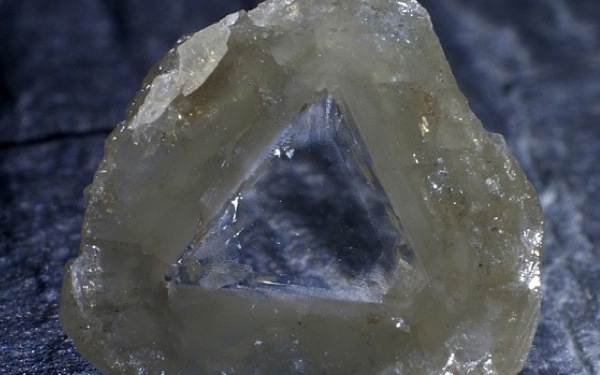
Diamond with a gem-quality core and fluid-rich “coat”. The coat contains millions of tiny fluid inclusions that trap pristine brine from 200 km depth. (Photo credit: Anetta Banas)
An international team of researchers has revealed that seawater may have played an important role in formation of diamonds hundreds of kilometres underground.
In a paper published Thursday in the journal Nature, scientists from Canada, the U.S. and the U.K suggest diamonds form as a result of plate tectonics carrying seawater into deep parts of the earth.
The team came to such conclusion after they found microscopic, dirty diamonds from the Ekati mine in Canada’s Northwest Territories, home to rich deposits of high and low quality gems.
“Ugly little things”
The diamonds provided to the researchers by Dominion Diamonds aren’t fit for a ring by any stretch of the imagination — they’re far less than a millimetre wide and “fibrous” or cloudy. Scattered throughout the crystal are droplets of fluid — millions of them, in some cases.
However, the tiny rocks were key to the study. “With the ringwoodite discovery, we showed there is a lot of water trapped in really deep parts of the Earth, which probably all came from recycling ocean water,” Graham Pearson, professor in the University of Alberta’s Department of Earth and Atmospheric Sciences and Canada Excellence Research Chair in Arctic Resources, said in a statement.
“This new study really highlights that process—it clearly demonstrates that ocean water in this case has been subducted via an old oceanic slab into a slightly shallower but still very deep part of the Earth. From there it has pumped that brine into the bottom of the root beneath the Northwest Territories, and it’s made the diamonds,” Pearson added.

Fluid-rich diamonds formed 200 km beneath Earth’s surface offer clues to how diamonds are made—and possibly how they can be found, according to new U of A research.
Although high-quality gem diamonds are normally estimated to have been formed three billion to 3.5 billion years ago, these poor-quality, fluid-rich diamonds appear to be just a few hundred million years old—significantly younger in the Earth’s geological timeline.
One theory to explain this age difference is that the two types of diamonds are actually formed by similar processes, and then over time the fluid-rich stones transform into the gem diamonds. Pearson and his team plan to do further studies on the fluids found in these diamonds to test this model.
Comments
Adam M Kerbali
That’s no proof that seawater has any role in diamond formation! It only says that the normal process of formation for this particular diamond formation was disturbed by the intake of water and lead to useless diamonds 🙂